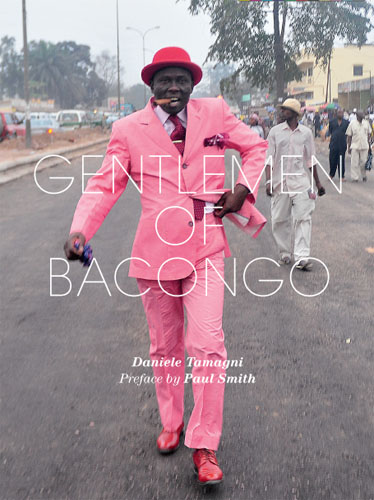IA: Since photography in Latin America encompasses all types of aesthetics including documentary, conceptual and experimental formats, among others, heterogeneity is probably its only unifying element. What is clear to me is that Latin American photography moves in multiple ways; in some instances the works reflect the contextual realities of their site production while in others they reference global issues. Certainly Latin American Photography today does have a multicultural character and moves beyond local artistic circuits.
Category: Interviews
-
Idurre Alonso (Curator, MoLAA): In Conversation – The New York Photo Festival
-

Talking to…Photographer Daniele Tamagni
Talking to…Photographer Daniele Tamagni
Milan-based photographer Daniele Tamagni’s book “Gentlemen of Bacongo” features the pageantry of Congalese sapeurs, or dandies – a subculture of men who pay extreme attention to, and take great pri…
Link: https://boywithgrenade.org/2010/05/06/talking-to-photographer-daniele-tamagni/
Milan-based photographer Daniele Tamagni’s book “Gentlemen of Bacongo” features the pageantry of Congalese sapeurs, or dandies – a subculture of men who pay extreme attention to, and take great pride in, their appearance and sartorial style.
-
Tips for Starting A Photo Career in an Unlikely Location – The Photoletariat
Andrew Spear is a freelance photographer living in Southeast Ohio. What’s intriguing is without any sort of internship , Andrew has already established himself in a crowded industry, all while still being a full time student. At only 21 years old and a month from graduating from the School of Visual Communication at Ohio University, he’s already photographed assignments for the New York Times, the Wall Street Journal and AARP Bulletin.
-
Conscientious Extended | A Conversation with Yann Gross
Almost everybody wants to belong to a group or a family and share their daily life activities/experiences. To define their own identities is important for every human being and to be part of a community is universal…
I’m interested how people interact and behave in a group, the use of symbols or dress codes.
-
Adrian Valenzuela does the Derby. | A Photography Blog
I planned on lighting the rink with multiple lights but quickly learned that Roller Rinks built way back when don’t have electrical codes of today. The only available outlet I found was at a DJ booth pretty far from the track. I was only able to use one light that night, but it was a blessing in disguise.
-
Passion and Personal Photo Projects with Nick Vedros – A Picture's Worth
As we pack our bags (complete with extra wet naps for a little bbq) and put the finishing touches on the event details with the folks at Digital Labrador, we thought we’d take a moment to check in with the man behind our day two shoot, Canon Explorer of Light Nick Vedros. What’s he passionate about shooting? What are his tips for building and maintaining a successful commercial career? And what’s he got up his sleeve for next weeks workshop?
-

Stanley Greene’s Redemption and Revenge – Lens
Stanley Greene’s Redemption and Revenge
In his pictures and his words, Stanley Greene is outspoken. Michael Kamber interviewed this freewheeling figure.
via Lens Blog: https://archive.nytimes.com/lens.blogs.nytimes.com/2010/07/22/shoptalk-7/
I wanted to set the record straight. I kept hearing people say, “Chechnya was when you really started to be a photographer.” And that’s not true. I was shooting back at the Berlin Wall, but nobody knew about it. I fell through the cracks. I wanted a way to say that my influences are not the ones you think they are. They are about painting. They are about music. They are about other things. The way I’ve been shooting really hasn’t changed since back in the ’70s, before all these new photographers emerged. My old work, like rock and roll, really nails it.
-
INTERVIEW: "Interview with Bruce Jackson" (2009)
Bruce Jackson was first drawn to work in prisons during the folk revival of the 1960s. Inspired by folk music collectors like the Lomaxes, he set out to capture work songs sung by African-American convicts, going first to Midwestern prisons when he was a graduate student in Indiana, and later to Texas state prisons while a fellow at Harvard. Over many years and in many prisons, he found and recorded the songs he was looking for, conversations with inmates, guards, and wardens, and thousands upon thousands of photographs.
-
Conscientious Extended | A Conversation with CPC 2010 Winner Oksana Yushko
I currently live in Moscow. It’s a huge metropolis. Living here you get used to people, speed, vanity, the subway… Do you know that the subway is a whole individual city of people inside Moscow? And when you come to any village in the north of Russia, like Kenozero, you meet the silence. There, you meet amazing people, you are surrounded by the beauty of nature, and you just shoot the first picture and that’s it. You see to it that you will come back there again and again. You listen to these people, their stories, their dreams and you need nothing else. For me, it just happened that way.
-
The Trials and Tribulations of a Commercial Photographer in Austin – A Picture's Worth
Following on the heels of my interview with Darren Carroll about using his iPad to supplement his printed portfolio, I asked him about the difficulties of living in Austin while trying to build more of a commercial business — and while most of the clients he’d like to work with are sitting on the coasts. I thought his methodical nature would provide good fodder and inspiration for other photographers trying to take it to the next level.
-
A Moment With Larry Fink – NYTimes.com
The moment that we have is the only moment we will ever have, insofar as it is fleeting. Every breath counts. So does every moment and perception. It’s a way to be alive. I am involved with the idea of reaching deeply into the pulsing matter of what it means to be alive and being vulnerable and seeing if I can cast an emotional legacy about being human.
-
On The Front Lines in Cairo with Photojournalist Matthew Cassel – A Picture's Worth | PhotoShelter
Things are changing fast in Egypt right now, and freelance photographer and journalist Matthew Cassel is experiencing it head-on. Cassel, who has been living and traveling throughout the Middle East since the age of 21 and speaks near fluent Arabic, is covering the events as they unfold in and around Cairo’s Tahrir Square.
-
Even the Middle Ground Is Perilous in Cairo: Nine Photographers Describe Their Experience – NYTimes.com
Photographers of the increasingly violent upheaval in Egypt are being forced — in the interest of personal safety — to adopt practices that limit their range of coverage at exactly the moment the world is hungriest for as many images from as many perspectives as possible.
According to interviews on Thursday with nine photojournalists in Cairo, it is often hard to photograph demonstrators for President Hosni Mubarak, because they are so openly hostile to journalists. On the defensive, photojournalists also find themselves traveling in packs (which they do not typically like to do), staying away from whole sections of Cairo (which is anathema) and donning helmets (which raises the likelihood they will be mistaken for government spies).
-

Cairo Photographer Sees Hope in Turmoil: Scott Nelson Tells What It's Like – NYTimes.com
Cairo Photographer Sees Hope in Turmoil
Scott Nelson, who has been in Cairo for a decade, finds reason for very cautious optimism in the events that have upended his adopted home.
via Lens Blog: http://lens.blogs.nytimes.com/2011/01/30/cairo-photographer-sees-hope-in-turmoil/
Scott Nelson, 40, is a freelance photographer who works regularly for The New York Times. He’s from Denver but has been based in Cairo for a decade. For this post, he spoke with James Estrin late Saturday and followed that by elaborating on his experiences and expectations as a photojournalist and as a Cairo resident.
